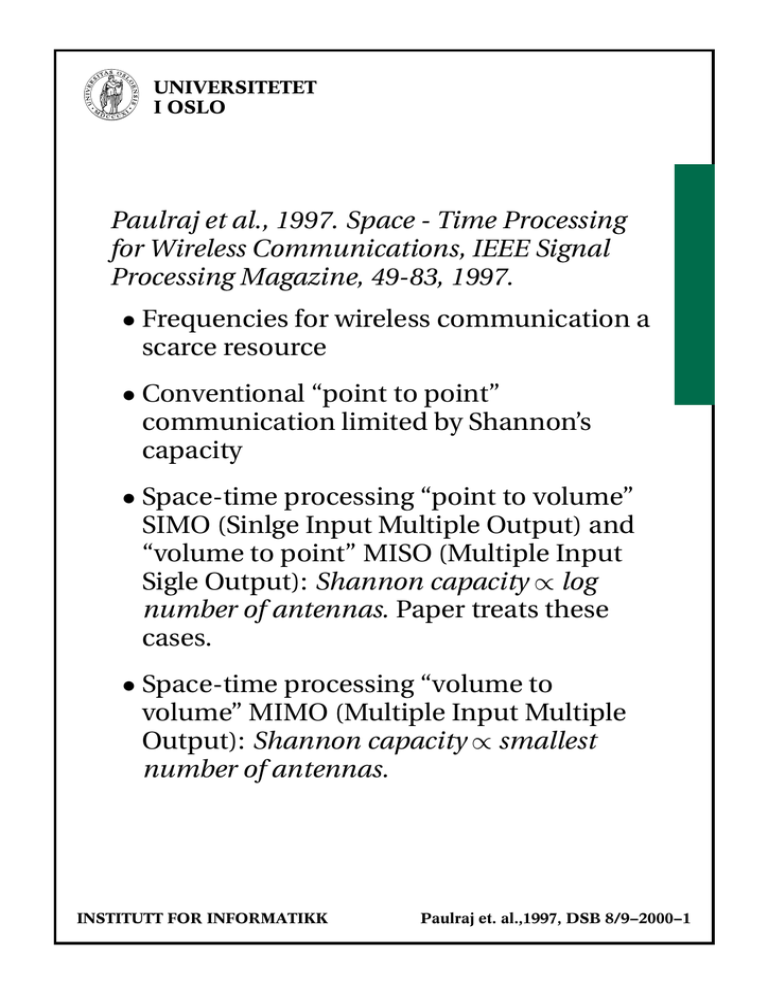Paulraj et al., 1997. Space - Time Processing
advertisement

UNIVERSITETET I OSLO Paulraj et al., 1997. Space - Time Processing for Wireless Communications, IEEE Signal Processing Magazine, 49-83, 1997. • Frequencies for wireless communication a scarce resource • Conventional “point to point” communication limited by Shannon’s capacity • Space-time processing “point to volume” SIMO (Sinlge Input Multiple Output) and “volume to point” MISO (Multiple Input Sigle Output): Shannon capacity ∝ log number of antennas. Paper treats these cases. • Space-time processing “volume to volume” MIMO (Multiple Input Multiple Output): Shannon capacity ∝ smallest number of antennas. INSTITUTT FOR INFORMATIKK Paulraj et. al.,1997, DSB 8/9−2000−1 UNIVERSITETET I OSLO Channel modelling • Path loss — Pr ∝ Pt/Dν , ν = 2.5 − 5. Pr - transmitted power, Pr - received power • Fading - spatial variability in electromagnetic field (Figure 2). — α(t) = αs(t)αr (t) ∗ αs(t) - slow fading (log normal) ∗ αr (t) - short term fading (Rayleigh or Rician) — Doppler, delay spread and angle spread (Fig. 3). INSTITUTT FOR INFORMATIKK Paulraj et. al.,1997, DSB 8/9−2000−2 UNIVERSITETET I OSLO Channel model - reverse link (mobile-to-base), SU-SIMO, TDMA (Fig. 6) xi(t) = PL R l=1 ai (θl )αl (t)u(t − τl ) + ni(t) • xi - received (baseband) signal at i-th array element • L - number of multipaths • ai(θl ) - response og i-th array element to signal along path l arriving at angle θl • αlR (complex) fading along path l • u(t − τl ) - transmitted signal along path l delayed by τl ⇒ ISI - Inter symbol interference. P Here u(t) = i g(t − iT )s(i) — g(·) - pulse shaping waveform — s(k) - symbol (information bits) — T - symbol length • ni(t) - additive noise INSTITUTT FOR INFORMATIKK Paulraj et. al.,1997, DSB 8/9−2000−3 UNIVERSITETET I OSLO Consider all elements xi(t) and define the array response vector a(θl ) = [a1(θl )a2(θl ), · · · , am(θl )]T . Channel model - reverse link (mobile-to-base), SU-SIMO x(t) = L X a(θl )αlR(t)u(t − τl ) + n(t) l=1 Channel model - reverse link (mobiles-to-base), MU-SIMO (Q - users ⇒ CCI - Co Channel Interference) x(t) = Q X L X R a(θlq )αlq (t)uq (t − τlq ) + n(t) q=1 l=1 INSTITUTT FOR INFORMATIKK Paulraj et. al.,1997, DSB 8/9−2000−4 UNIVERSITETET I OSLO Channel model - forward link (base-to-mobile), SU-MISO Space only: w beamforming weight vector x(t) = L X wH a(θl )αlF (t − ti)u(t − τl ) + n(t) l=1 Space-time : x(t) = X wiH i L X a(θl )αlF (t)u(t − τl − ti) + n(t) l=1 Channel model - forward link (bases-to-mobile), MU-MISO Space only - signal received at user d of Q: xd(t) = Q X q=1 wqH L X F a(θld)αld (t)uq (t−τld−ti)+nd(t) l=1 INSTITUTT FOR INFORMATIKK Paulraj et. al.,1997, DSB 8/9−2000−5 UNIVERSITETET I OSLO Reverse link (mobile-to-base), SU-SIMO Converts to “symbol response” channel model. Sample at symbol rate tk = kT . P We have u(tk ) = i g(tk − iT )s(i). Assume min(τl ) < 1 symbol length and max(τl ) is the channel length corresponding to N symbol lengths. x(k) = L X a(θl )αlR(t)u(tk − τl ) + n(k) l=1 = Hs(k) + n(k) Since a(θl ) is (m × 1), H is (m × N ) and s(k) .. s(k − N + 1) INSTITUTT FOR INFORMATIKK Paulraj et. al.,1997, DSB 8/9−2000−6 UNIVERSITETET I OSLO Reverse link (mobiles-to-base), MU-SIMO. Symbol response model with CCI x(k) = Hsss(k) + Q X Hq sq (k)n(k) q=1 “Final and versatile block model” Define X(k) = [x(k), · · · , x(k + M − 1)] , (m × M ) X(k) = HS(k) + N(k) S(k) = [s(k), · · · , s(k + M − 1)] , (N × M ) Toeplitz N(k) = [n(k), · · · , n(k + M − 1)] , (m × M ) INSTITUTT FOR INFORMATIKK Paulraj et. al.,1997, DSB 8/9−2000−7 UNIVERSITETET I OSLO • Given channel parameters - easy to compute H • The challenge: Compute H and S from X • Ill-posed problem - requires regularization offered through structure (Figure 8) • Assume first reverse link with H known — Time only equalizer - generally effective against ISI but not CCI (Figure 9) — Space only array processor - generally effective against CCI but not ISI (Figure 10) — Space-time offers better performance INSTITUTT FOR INFORMATIKK Paulraj et. al.,1997, DSB 8/9−2000−8 UNIVERSITETET I OSLO Reverse link (mobile-to-base) space-time , SU-SIMO, H known • ST - MLSE (Maximun Likelihood Sequence Estimation) N Gaussian white in space and time: argminS ||X − HS||2F (Not a regression problem) Use Viterbi algorithm to carry out a “dynamic programming like” search Does not generalize well to correlated noise/interference. CCI problematic. • ST - MMSE (Minimum Mean Square Error) Handles CCI better, but not as good at handling ISI. INSTITUTT FOR INFORMATIKK Paulraj et. al.,1997, DSB 8/9−2000−9 UNIVERSITETET I OSLO Some blind identification methods • Iterated MLSE (Maximum Likelihood Sequence estimation) • DOA (Direction Of Arrival) techniques from array processing • CM (Constant Modulus) methods (special case of Bussgang algorithms) • Unmixing through HOS (Higher Order Statistics) • Polyphase methods INSTITUTT FOR INFORMATIKK Paulraj et. al.,1997, DSB 8/9−2000−10